
Bochasanwasi Akshar Purushottam Swaminarayan Sanstha is a Hindu denomination within the Swaminarayan Sampradaya. It was formed in 1905 by Shastri Yagnapurushdas following his conviction that Swaminarayan remained present on earth through a lineage of gurus starting with Gunatitanand Swami. As of August 2016, Mahant Swami Maharaj is the 6th guru and president of BAPS.

Pramukh Swami Maharaj was the guru and Pramukh, or president, of the Bochasanwasi Akshar Purushottam Swaminarayan Sanstha (BAPS), a major branch of the Swaminarayan Sampradaya, a Hindu denomination. BAPS regards him as the fifth spiritual successor of Swaminarayan, following Gunatitanand Swami, Bhagatji Maharaj, Shastriji Maharaj, and Yogiji Maharaj. He was believed by his followers to be in constant communion with Swaminarayan, and ontologically, the manifestation of Akshar, the eternal abode of Swaminarayan.

Yogiji Maharaj, born Jina Vasani, was a Hindu swami and the fourth spiritual successor of Swaminarayan in the Bochasanwasi Akshar Purushottam Swaminarayan Sanstha (BAPS), a major branch of the Swaminarayan Sampradaya. According to the metaphysics of BAPS, Yogiji Maharaj is considered to be the next iteration of Akshar after Shastriji Maharaj in the guru parampara, an unbroken line of "perfect devotees" who provide "authentication of office through Gunatitanand Swami and back to Swaminarayan himself." Together with Pramukh Swami Maharaj, who acted as the administrative head of BAPS, he was instrumental in nurturing the growth of BAPS "through new programs, expansion into new areas, and the construction of temples".
The Laksmi Narayan Dev Gadi is one of the two gadis (diocese) that together form the Swaminarayan Sampradaya. It is headquartered at the Shri Swaminarayan Mandir, Vadtal and controls the Dakshin Vibhag Lekh.

Gunatitanand Swami, born Mulji Jani, was a prominent paramhansa of the Swaminarayan Sampradaya who was ordained by Swaminarayan and is accepted as the first spiritual successor of Swaminarayan by the Bochasanwasi Akshar Purushottam Swaminarayan Sanstha (BAPS). Born into a religious family in the small farming community of Bhadra in Gujarat, India, he first received religious education under his father's guru, Ramanand Swami, before encountering Swaminarayan and becoming a swami under him at the age of 25. He was revered for his spiritual discourses and divine service.

The BAPS Shri Swaminarayan Mandir of Houston, Texas is a traditional Hindu temple built by the BAPS Swaminarayan Sanstha. It is in unincorporated Fort Bend County, Texas, within the extraterritorial jurisdiction (ETJ) of Stafford and with a Stafford mailing address.

The BAPS Shri Swaminarayan Mandir of Chicago, Illinois is a traditional Hindu place of worship built by the BAPS Swaminarayan Sanstha. The BAPS Swaminarayan Sanstha, which is headed by Mahant Swami Maharaj, is a denomination of the Swaminarayan Sampradaya within Hinduism. The mandir is located in the Chicago suburb of Bartlett and opened on August 7, 2004. It was built of hand-carved Italian marble and Turkish limestone. The mandir is the largest of its kind in Illinois and was constructed in accordance to the Shilpa shastras. The mandir complex spreads over 27 acres and includes the mandir and the haveli.
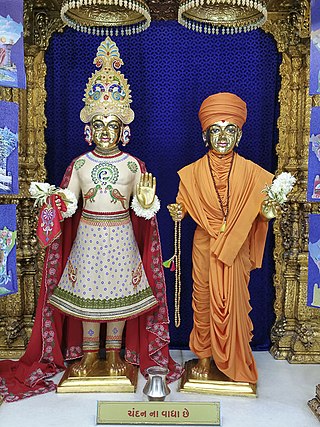
Bochasan is a village in Anand district, Gujarat, western India. It is known primarily as the origin of Bochasanwasi Shri Akshar Purushottam Swaminarayan Sanstha (BAPS), so named because its first formal center was established in Bochasan in 1907 by its guru Shastriji Maharaj.
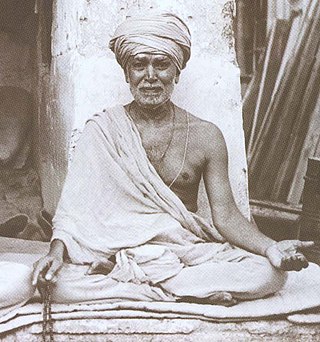
Shastriji Maharaj, born Dungar Patel and ordained Shastri Yagnapurushdas, was a swami of the Swaminarayan Sampradaya and founder of the Bochasanwasi Akshar Purushottam Swaminarayan Sanstha (BAPS). Several branches accept him as the third spiritual successor of Swaminarayan in the lineage of Aksharbrahma Gurus through whom Swaminarayan manifests, which began with Gunatitanand Swami. Born in a family of farmers in central Gujarat, India, he became a swami within the Vadtal diocese of the Swaminarayan Sampradaya at the age of 17 where he was given the name Yagnapurushdas Swami. The prefix Shastri was later added in recognition of his eminent scholarship in Sanskrit and the Hindu scriptures. He established BAPS after a doctrinal split from the Vadtal diocese of the Swaminarayan Sampradaya.

Shri Swaminarayan Mandir, Junagadh, also called ShriRadha Ramana Temple, Junagadh is a Hindu temple in Junagadh, Gujarat, India. This temple was ordered to be built by Swaminarayan himself, the founder of the Swaminarayan Sampradaya.

Shri Swaminarayan Mandir, Dholera is a Hindu temple in Dholera, Gujarat, India, and is one of nine Shri Swaminarayan Temples built by Swaminarayan.

The BAPS Shri Swaminarayan Mandir in Atlanta, Georgia is a traditional Hindu mandir, or place of worship, inaugurated on August 26, 2007, by the BAPS Swaminarayan Sanstha, a denomination of the Swaminarayan branch of Hinduism headed by Mahant Swami Maharaj. The mandir is located in the Lilburn suburb of Atlanta and was constructed in accordance with the Shilpa shastras, which are ancient Hindu architectural scriptures. It was the largest mandir of its kind outside of India. The mandir is made of 34,450 pieces of hand-carved Italian marble, Turkish Limestone and Indian pink sandstone, and are all situated on over 30 acres of landscaped grounds. The mandir complex also includes a large assembly hall, family activity center, classrooms, and an exhibition on the key tenets of Hinduism. Baps Atlanta Mandir is a remarkable place of joy and internal peace.

The BAPS Shri Swaminarayan Mandir in Etobicoke, Toronto, Ontario, Canada is a traditional Hindu place of worship that was built by the BAPS Swaminarayan Sanstha. The BAPS Swaminarayan Sanstha, which is headed by Mahant Swami Maharaj, is a global spiritual organization within the Swaminarayan branch of Hinduism. The mandir was built in 18 months and consists of 24,000 pieces of hand-carved Italian carrara marble, Turkish limestone and Indian pink stone. The mandir is the largest of its kind in Canada and was constructed according to guidelines outlined in ancient Hindu scriptures. The grounds spread over 7.3 hectares and in addition to the mandir, include a haveli and the Heritage Museum. The mandir is open daily to visitors and for worship. On June 26, 2023, the temple celebrated its 16-year anniversary.

The Swaminarayan Sampradaya, also known as Swaminarayan Hinduism and Swaminarayan movement, is a Hindu Vaishnava sampradaya rooted in Ramanuja's Vishishtadvaita, characterized by the worship of its charismatic founder Sahajanand Swami, better known as Swaminarayan (1781–1830), as an avatar of Krishna or as the highest manifestation of Purushottam, the supreme God. According to the tradition's lore, both the religious group and Sahajanand Swami became known as Swaminarayan after the Swaminarayan mantra, which is a compound of two Sanskrit words, swami and Narayan.
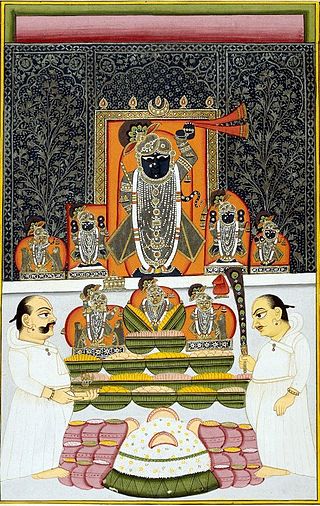
Govardhan Puja, also known as Annakut or Annakoot, is a Hindu festival celebrated on the first lunar day of the bright fortnight of the month of Kartika, on the fourth day of Diwali. Devotees worship Govardhan Hill and prepare and offer a large variety of vegetarian food to Krishna as a mark of gratitude. For Vaishnavas, this day commemorates the incident in the Bhagavata Purana when Krishna lifted Govardhan Hill to provide the villagers of Vrindavan shelter from torrential rains. This incident symbolizes God offering protection to devotees who take singular refuge in him. Devotees offer a mountain of food, metaphorically representing the Govardhan Hill, to God as a ritual remembrance and to renew their faith in taking refuge in God. The festival is observed by most Hindu denominations all over India and abroad.
The International Swaminarayan Satsang Mandal (ISSM) is a religious organisation of the Hindu faith based in USA. It comes under the Laxmi Narayan Dev Gadi of the Shree Swaminarayan Sampraday. The organisation has temples and centres in various parts of the country as well as a temple in Chicago, Illinois (America).
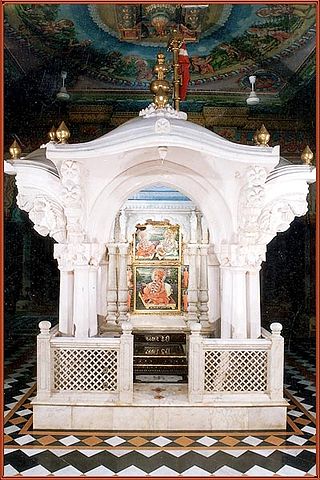
The Akshar Deri is a major site of pilgrimage in the Swaminarayan Sampradaya and is located in the rang mandap of the BAPS Swaminarayan temple in Gondal, India. The structure marks the cremation site and serves as a memorial to Gunatitanand Swami. An event was held to commemorate 150 years of the structure in Gondal, the structure as well as the site was renovated to bring it to modern standards.

The BAPS Shri Swaminarayan Mandir in Edison, New Jersey is a Hindu temple built by the BAPS Swaminarayan Sanstha, a Hindu denomination within the Swaminarayan Sampradaya. The first BAPS mandir built in Edison was consecrated by Pramukh Swami Maharaj in August 1996. In 2019, a new mandir was built on the same property and a re-inauguration ceremony was conducted by senior monastic disciples.
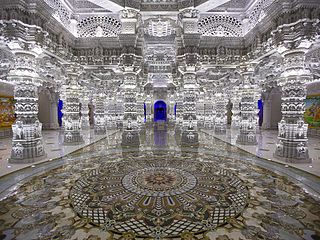
The BAPS Shri Swaminarayan Mandir in Robbinsville in Central New Jersey is a Hindu place of worship built by the BAPS Swaminarayan Sanstha and consecrated by Pramukh Swami Maharaj.

















